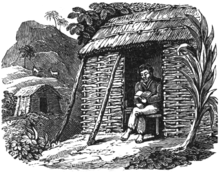Alexander Selkirk
Alexander Selkirk (1676 – 13 December 1721) was a Scottish privateer and Royal Navy officer who spent four years and four months as a castaway (1704–1709) after being marooned by his captain, initially at his request, on an uninhabited island in the South Pacific Ocean.Stradling's ship stopped to resupply at the uninhabited Juan Fernández Islands, west of South America, and Selkirk judged correctly that the craft was unseaworthy and asked to be left there.By the time he was eventually rescued by the privateer Woodes Rogers, who was accompanied by Dampier, Selkirk had become adept at hunting and making use of the resources that he found on the island.His story of survival was widely publicized after his return, becoming one of the reputed sources of inspiration for the English writer Daniel Defoe's fictional character Robinson Crusoe.In 1703, he joined an expedition of English privateer and explorer William Dampier to the South Pacific Ocean,[6] setting sail from Kinsale in Ireland on 11 September.[7] They carried letters of marque from the Lord High Admiral authorizing their armed merchant ships to attack foreign enemies as the War of the Spanish Succession was then going on between England and Spain.[5] In February 1704, following a stormy passage around Cape Horn,[10] the privateers fought a long battle with a well-armed French vessel, St Joseph, only to have it escape to warn its Spanish allies of their arrival in the Pacific.[13] In September 1704, after parting ways with Dampier,[14] Captain Stradling brought Cinque Ports to an island known to the Spanish as Más a Tierra located in the uninhabited Juan Fernández archipelago 670 km (420 mi) off the coast of Chile for a mid-expedition restocking of fresh water and supplies.More foods were available there: feral goats—introduced by earlier sailors—provided him with meat and milk, while wild turnips, the leaves of the indigenous cabbage tree and dried Schinus fruits (pink peppercorns) offered him variety and spice.[30] Captain Rogers was impressed by Selkirk's physical vigour, but also by the peace of mind that he had attained while living on the island, observing: "One may see that solitude and retirement from the world is not such an insufferable state of life as most men imagine, especially when people are fairly called or thrown into it unavoidably, as this man was.At Guayaquil in present-day Ecuador, he led a boat crew up the Guayas River where several wealthy Spanish ladies had fled, and looted the gold and jewels they had hidden inside their clothing.[34] His part in the hunt for treasure galleons along the coast of Mexico resulted in the capture of Nuestra Señora de la Encarnación y Desengaño,[35] renamed Bachelor, on which he served as sailing master under Captain Dover to the Dutch East Indies.His fellow crewman Edward Cooke mentioned Selkirk's ordeal in a book chronicling their privateering expedition, A Voyage to the South Sea and Round the World (1712)."[47] As the ship sailed down the coast of West Africa, men went into the forests to cut wood and began to contract yellow fever from the swarms of mosquitoes, and perhaps typhoid.In 1869 the crew of HMS Topaze placed a bronze tablet at a spot called Selkirk's Lookout on a mountain of Más a Tierra, Juan Fernández Islands, to mark his stay.[63] On 1 January 1966 Chilean president Eduardo Frei Montalva renamed Más a Tierra Robinson Crusoe Island after Defoe's fictional character to attract tourists.






Thomas Stuart BurnettLower LargoCape CoastGold CoastRobinson CrusoeprivateerRoyal Navycastawaymaroonedan uninhabited islandSouth Pacific Oceanyellow feverlieutenantHMS WeymouthbuccaneeringWar of the Spanish SuccessionCinque PortsWilliam DampierJuan Fernández IslandsfounderedMalpelo IslandWoodes RogersDaniel DefoeshoemakertannerKirk SessionKinsaleletters of marqueLord High Admiralcaptainsailing masterCape HornSanta Maríaambushedmerchantmanprize shipRobinson Crusoe IslandMás a TierraJuan Fernández archipelagoseaworthinessmuskethatchetspiny lobsterssea lionsferal goatsturnipscabbage treeSchinuspink peppercornsferal catsbarrelpepperprivateeringpilotedThomas Doverscurvysecond mateGuayaquilGuayas RivergalleonsNuestra Señora de la Encarnación y DesengañoDutch East IndiesCape of Good Hopethe DownsCrusoeA Voyage to the South Sea and Round the WorldRichard SteeleLondonfarthingshipwrightBristolPlymouthofficerRiver GambiaWest AfricatyphoidCape Coast Castleburied at seaThe Life and Surprising Adventures of Robinson CrusoeTim Severinmid-latitudesCaribbeantropicalWilliam CowperJorge Luis BorgesCharles DickensThe Pickwick PapersPatrick KavanaghW. S. GilbertBab BalladsJoshua SlocumSailing Alone Around the WorldDiana SouhamiAllan ColeChris BunchSelkirk, the Real Robinson Crusoestop motionWalter TournierThe Walt Disney CompanyLord AberdeenLady AberdeenHMS TopazeEduardo Frei MontalvaMás AfueraAlejandro Selkirk Islandarchaeologicalgreat-grand-nephewList of people who disappeared mysteriously at seaThe National Archives (United Kingdom)Chapman & HallBelknap PressOliver & BoydMariner's MirrorOxford University PressBasic BooksDover PublicationsCooper Square PressWikisourceDictionary of National Biography's1911 Encyclopædia BritannicaSpiegel OnlineThe ScotsmanSmithsonianGoogle MapsLibriVoxProject Gutenberg